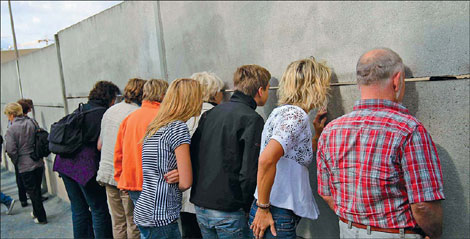Berlin Wall making comeback
|
Tourists look through a rebuilt section of the former Berlin Wall fortification at the memorial site in Bernauer Strasse on Tuesday. Thomas Peter / Reuters |
BERLIN - The Berlin Wall is making a comeback.
A half century after it was built and two decades after its demise, a few bits of the Wall that once split Berlin into East and West are being reinstated for posterity to the delight of tourists seeking a glimpse of the city's Cold War history.
Almost all of the 160 km Berlin Wall that encircled West Berlin in the heart of East Germany was hastily torn down or chiseled away in the euphoria after it was breached in 1989.
There were only a few withered remnants left by the time the two Germanys reunited less than a year later on Oct 3, 1990. Only three of the 302 East German guard towers still stood.
"There's a general complaint that the demolition of the Wall was a bit too extensive," said Berlin Mayor Klaus Wowereit.
"That's understandable from today's point of view, and it would have probably been better for tourists if more of it could have been preserved," he said. "But at that time, we were all just so happy to see the Wall gone."
There was indeed a powerful rush to obliterate all traces of the 3.6-meter-high concrete and barbed wire barrier, the building of which started on Aug 13, 1961.
"Mauerspecht" (wall-peckers) armed with hammers and chisels got souvenir chips and bulldozers did the rest, turning it into gravel and developing the prime real estate.
Many of the Wall slabs were sold, raising some 2 million Deutsche marks (then about $1 million) for the government. Some 300 East German border guards and 600 West German soldiers worked together to tear the rest down, converting it into 300,000 tons of concrete mass.
But now, as growing numbers of tourists come to Berlin each year searching largely in vain for traces of the Wall, the city has re-erected and restored parts while monument preservation experts are working to conserve other vestigial segments.
"At first, no one gave a second thought to the idea of preserving any of the Wall for future generations," said Jochen Staadt, a political scientist at Berlin's Free University.
But there was always interest from foreigners who came and say "Where's the Wall?", added Staadt, a specialist on East Germany and the Wall. "It took about a decade until the late 1990s before people in Berlin, especially those under 30, started taking an interest in what the Wall was actually like."
New buildings have gone up on many parts of the former "death strip" that separated East and West, and it is sometimes hard to tell where the barrier once stood.
In the last few years a piece of the Wall complex running six city blocks, or some 800 meters, has been rebuilt and restored on Bernauer Strasse, scene of some of the most dramatic escapes after the wall was built.
People jumped from upper story windows in buildings on the east side of the Wall onto the street on the west side. The windows were soon sealed off with bricks and the buildings later demolished.
In the early 1990s, the area around Bernauer Strasse was a veritable wasteland, with locals complaining about needles from drug addicts left behind in the weeds in the undeveloped land.
Part of the rebuilt section is made up of authentic Wall slabs, some purchased for 1,000 euros ($1,400) each from a private collector, and some of it is made of 3.6-meter-high rusting iron rods that symbolize where the Wall stood but have gaps that allow visitors to see through it.
Another four city blocks, or about 500 meters, of concrete Wall slabs and iron rods will be added next year.
Berlin, with help from the federal government and European Union, is spending some 28 million euros on the construction.
Reuters
(China Daily 08/11/2011 page10)



















